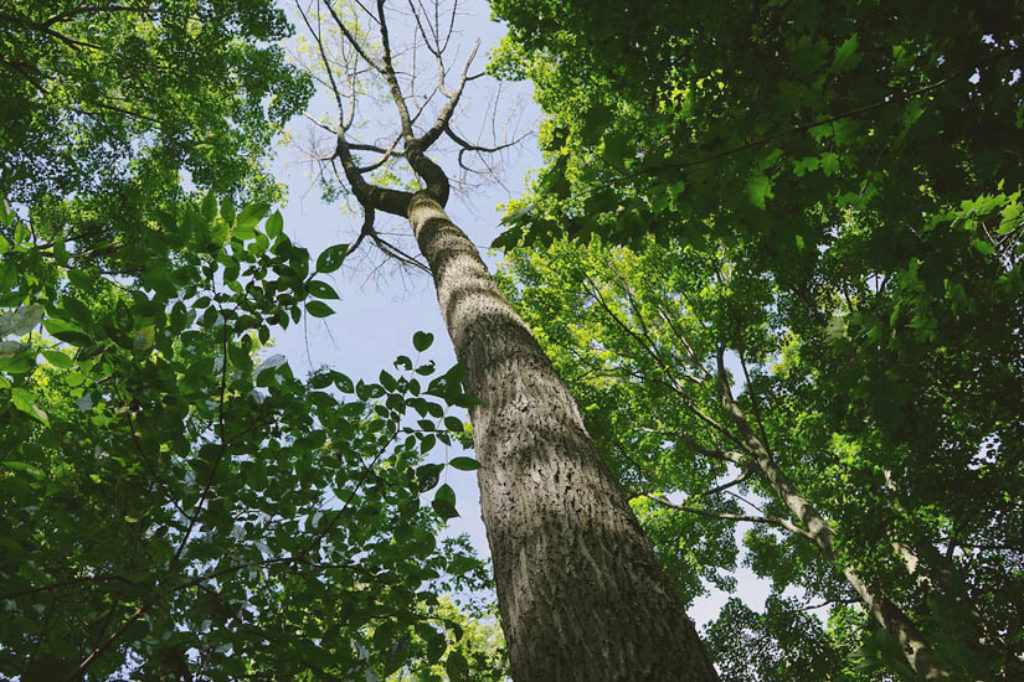
Ash trees may be more prepared to face invasive threats than previously realised.
The European ash (Fraxinus excelsior) is a common site in towns, forests and parkland across the United Kingdom. Since the 1990s, ash trees across Europe have been devastated by ash dieback, a disease caused by the fungal pathogen (Hymenoscyphus fraxineus), which has resulted in mortality rates of up to 85%. Even as ash dieback kills ash trees all across the continent, they are faced with another threat – the emerald ash borer (Agrilus planipennis).
The emerald ash borer is a small green beetle in the Buprestidae family, which lays eggs in bark crevices on ash trees. The larvae burrow through the bark to living tissues where they feed, leaving tunnels beneath the bark as they move around which fill with frass and eventually cut off the flow of water and nutrients to parts of the tree, causing them to wither and die. This species has severely impacted ash trees in Russia and the USA, and has been recorded to be spreading west across the Eurasian landmass by approximately 25 miles each year.
Research in Denmark has found that chemical signatures indicative of iridoid glycosides are associated with increased susceptibility to ash dieback. Unfortunately, iridoid glycosides are a plant’s defence chemicals, which are used to deter insects. This has raised the concern that selective breeding for ash dieback resistance may reduce the ability of ash trees to defend themselves against insect pests like the emerald ash borer.


A paper published in Plants, People, Planet (November 2019) from researchers at the Ohio State University, in association with the John Innes Crop Centre, the Royal Botanic Gardens and Queen Mary, University of London, reviews the resistance of the native European ash tree to emerald ash borer. The results seem to indicate that there is some good news for these trees in what has otherwise been a very unhappy recent history.
The researchers found that the European ash tree has ‘moderate’ resistance to the emerald ash borer. Notably, it was found to be significantly more resistant to the pest species than black ash (Fraxinus nigra) which has been severely affected by the emerald ash borer elsewhere in the world.
The research involved inoculating young trees that had been selected to be representative of trees across the UK with emerald ash borer. For comparison, a number of saplings of black ash (known to be susceptible to emerald ash borer) and Manchurian ash (Fraxinus mandschurica) (known to be resistant) were also inoculated with the pest. The results demonstrated that there was no significant difference between species in the number of eggs that hatched and formed galleries, but that significantly fewer larvae matured to later instars in European ash and Manchurian ash than in black ash.

The paper concludes that European ash is no more resistant to initial attack by this pest species than other species, but that it is better able to fend off the insect as it matures, restricting its development and reducing its impact. The emerald ash borer has so far not made its way to the UK, but the resistance displayed by the European ash suggests that they will be able to slow the progress of an emerald ash borer epidemic in the event that it does invade, and is good news for ash trees on the continent.
As to the question of whether or not selective breeding for ash dieback resistance will increase the susceptibility of ash trees to emerald ash borers – the researchers found that there was little or no evidence for genetic variation affecting the response of trees to emerald ash borers, which suggests that selective breeding in this way will likely will not affect the species resistance to insect pests. This was not the primary aim of the project, however, so the researchers recommend that further research will be necessary before stronger conclusions can be drawn.
This research shows that the outlook for European ash trees may not be as bleak as it first appears. They have an innate resistance to the emerald ash borer, which will likely remain strong even as scientists work to boost its defences against ash dieback, so the long term may find ash trees in Europe resisting both epidemics even as other ash species elsewhere in the world fall.
Read the full article:
Showalter, D., Saville, R., Orton, E., Buggs, R., Bonello, P. & Brown, J. (2019). Resistance of European ash (Fraxinus excelsior) saplings to larval feeding by the emerald ash borer (Agrilus planipennis). Plants, People, Planet, 2019; 00: 1-6.
To find similar articles, visit CABI’s Forest Science Database and use the search: [“european ash” AND (“ash borer” OR “insect pest”)]
Related News & Blogs
Biological control in action: Zambia’s field days on fighting fall armyworm
Experts from CABI recently held two field days and an expo in Zambia, showcasing innovative approaches to pest management to 584 farmers, agro-dealers and other stakeholders to help raise awareness of approaches to tackle the invasive fall armyworm (Sp…
11 June 2025




